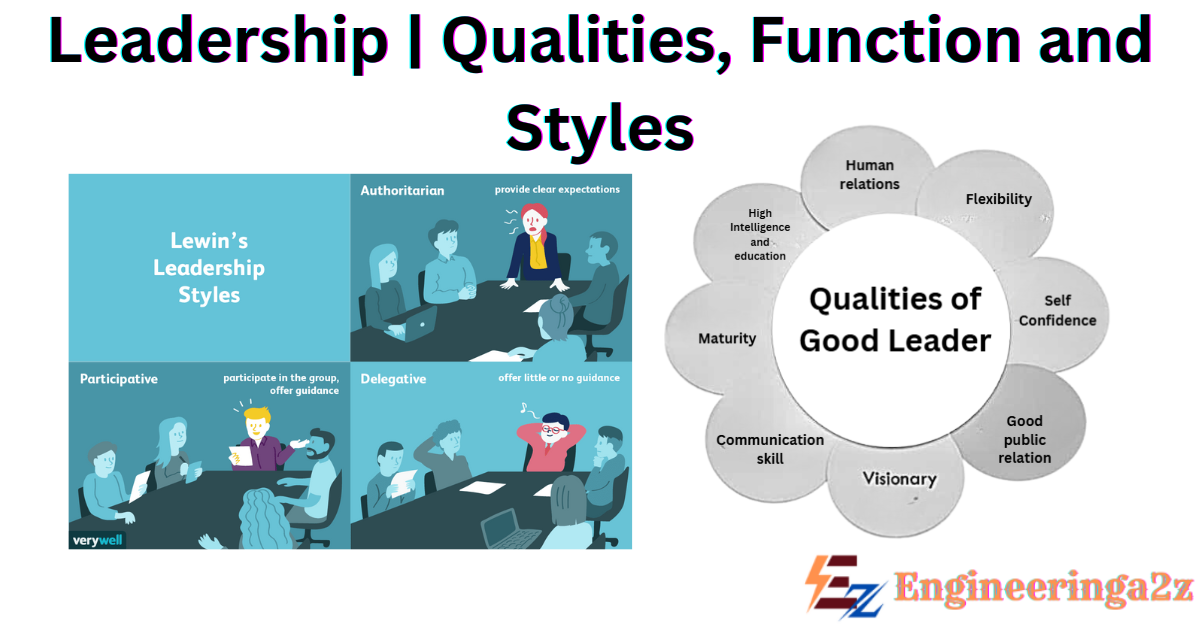
Table of Contents
Leadership
Leadership has been defined by Davis as follows:
Leadership is the ability to persuade others to seek defined objective enthusiastically. It is the human factor which binds a group together and motivates is towards goals.
Need of Leadership
Leadership is an important factor for making the organisation successful. Here we mean manager as a leader. Without a good leader, organisation cannot function efficiently and effectively. Any organisation is basically a deliberate creation of human beings for certain specified objectives. Therefore, the activities of the members need to be directed in a certain way.
The following points highlight the need of leadership for an organisation:
- To motivate employees: Motivation is necessary for work performance. Higher the motivation, better would be performance. A good leader by exercising his leadership motivates the employees for high performance and to achieve best results.
- To define objectives of organiston: It is the duty of the leader to define the objectives of the organisation and its various policies. A leader is also needed to co-ordinate the efforts of the members to achieve the desired goal.
- To create a team-spirit: A leader is also required in an organisation to create a team-spirit. An organisation will succeed only where all its members work as a team instead of individuals. This is possible only when there is an efficient leader available to co-ordinate their efforts as a team.
- To handle difficult situation: Sometimes, there are such situations when the workers feel what to do. These are delicate and difficult situations, which need immediate attention. Only a good leader can guide the workers in such a situation. This creates a sense of confidence among the workers which improves their working.
- To develop a sense of participation among workers: A good leader properly guides, directs and leads the workers. This creates confidence among the workers. A good leader keeps the followers committed to the objectives for which they are working by developing a sense of participation.
Qualities of Good Leader
The qualities of a good leader are:

- Human relations: A good leader should have adequate knowledge of human relations and human psychology. Since an important part of a leader’s job is to develop people and their voluntary co-operation for achieving work. The knowledge of how human beings behave and how they react to various situations is quite meaningful to a leader. His attitude should be sympathetic and helpful in dealing with the problems of his subordinates.
- High Intelligence and education: He should have high intelligence to group facts, figures and to understand people. His formal education should be as for as possible be in accordance with his profession.
- Maturity: He should be emotionally stable and unlikely to break down with frustration while handling situation and making decision.
- Communication skill: A successful leader know how to communicate effectively. he has the skill to convey his message to his subordinates.
- Flexibility: An essential quality of a good leader is the ability to adopt himself and quickly adjust to changing situation.
- Self Confidence: Self assurance, self reliance, inner security and a strong will power make him a confident person.
- Vision: A good leader possesses foresight, sees new trends and opportunities and anticipates future events.
- Good public relation: A good leader is always careful to see that all his action are not only good, but appears to be good also.
Function of a Leader
The following are some functions which a leader has to perform in general:
- To define objectives: The leader clearly defines the objectives of the organisation to the workers. He sets the targets and finds ways and means to achieve the pre- decided target.
- To prepare plans: The leader makes plans and makes his subordinates clearly understand the line of action to execute these plans.
- To guide and co-ordinate: The leader in an organisation guides his followers and co-ordinates their efforts in such a way that the desired goal of the organisation is achieved.
- To control and motivate: The leader has a direct control over the activities of his followers and he motivates them to achieve the goal.
- To increase production: The leader takes all possible steps to increase the production and maximize the profit of the organisation. He also takes necessary steps to reduce wastage of materials, time and manpower.
Types/Styles of Leadership
There are three styles of leadership are:
- Autocratic leadership (Authoritarian)
- Democratic leadership (Participative)
- Laisse-faire (Free-rein)
1. Autocratic Leadership
This is also known as authoritarian or directive style. In this style, a manager centralises decision-making power in himself. He structure the complete work situation for his employees and they do what they are told.
The main characteristics of this style are as follows:
- The leader makes all the decision and demands from the people he supervises.
- All policies are decided by the leader without consulting the subordinates.
- In this system, Decision can be taken quickly.
2. Democratic Leadership
This style is also called democratic, consultative or ideographic. A democratic manager decentralises his decision-making process. Instead of taking unilateral decision, he emphasises consultation and participation of his subordinatess.
The main Characteristics of this style are as follows:
- A democratic leader promotes participation of subordinates and develops strong team work.
- The leader gives decision only after consulting his subordinate.
- They share the responsibility with the superior and try to safe guard him also.
3. Laisse-Faire
A laisse- Faire leader avoids power and responsibility. Such a leader depends largely upon the group to establish its own goals and decision.
The main characteristics of this style are as follows:
- The leader acts as an information center and exercise minimum of control.
- The leader supplies various materials, gives information when asked, but does not participate in work discussion.
- The subordinate group establishes its own goals and solves its own problems.
Frequently Asked Questions (FAQs)
Define Leadership?
The art of planing, leading, and guiding the activities of a group of people to achieve a common goal is known as leadership.
Which are the different style/types of leadership?
There are three type/style of leadership are:
1. Autocratic leadership
2. Democratic leadership
3. Laisse-faireWhat are the 7 C’s of leadership success?
Those seven C’s are competence, creativity, courage, communication, coaching, compass, and citizenship.
Related Posts
- Leadership | Qualities, Function and Styles
- Elementary Concepts | VAT, GATT, WTO, and TRIPS
- Globalisation | Dimensions, Causes, Merits, and Demerits
- Privatisation | Measures, Causes, Objectives, and Advantages
- Production | Methods, Factors, and Importance
- Macro Economics | Scope, Uses, and Limitations












Leave a Reply